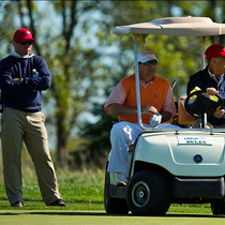Slow play is one of the most talked about issues in the game of golf today. When it takes closer to six hours than to four hours to play, it diminishes the quality of the golf experience for everyone, and actually deters people from playing golf more or at all. This is a problem locally and nationally, and at all levels of play as well. Slow play isn’t just slow players–pace of play can be slowed by other factors including course set-up and golf operations. While you can’t control these factors, you can control your own habit and your own pace–and help others do the same!
There are two types of slow players–the “slow golfer” and the “inefficient player.” My definition of a slow golfer is one that takes a significant amount of time to play a stroke and is very deliberate. They pace off their yardage from a sprinkler head only to then use their range finder or GPS unit to see how accurate the number is, followed by throwing blades of grass in the air to make sure the wind is not “swirling”. Then they stand in back of the golf ball to visualize their shot, taking numerous practice swings to “get a feel” for it, only to then stand over the ball for an additional 30 seconds with a series of shuffles and wiggles until they finally begin to swing. And when they eventually get to the green they have to look at their first putt from three angles, and then four on the second putt. Heaven forbid there’s a third putt!
Most golfers who are perceived as “slow golfers” actually are “inefficient players”–they actually take very little time to hit their ball when they are ready to do so, but it is all of their inefficient habits between shots that slow down play. Here are my three tips to everyone to help speed up play without changing your shot routine.
1. Play when ready. When you are out playing a casual round or in a stroke play competition, play “ready golf”. Many golfers feel that the person furthest from the hole must play first and you cannot play out of turn. This is only true in a match play competition. Generally, if there are two players ready to play, the one furthest from the hole should be first out of courtesy. There is no penalty in stroke play for playing out of turn, unless the players are doing so to give another an advantage. So if you are riding in a cart and you get to your ball first, and the walker in the group who is further from the hole has not got to his ball yet, go ahead and play.
2. Play your ball first, then help search. Helping players in your group search for their errant shots is certainly a way to keep pace moving along. But help with the search after playing yours (if it is clear ahead for you to play). You’ll be surprised how much this helps over the course of the round.
3. Play a provisional. When you think your ball may be out of bounds or lost outside a water hazard, declare and play a provisional ball. The intent of this Rule (Rule 27-2) is to help speed up play because if your ball is out of bounds or lost outside a water hazard, the player’s only option is stroke and distance. Players are always very hesitant to play a provisional, whether because of embarrassment or some other reason, but I have always felt it would be more embarrassing to have to walk back to where you last played with the group behind you watching. I have also always thought of a provisional as an opportunity to correct what you did wrong.
These are just three of many ways you can speed up play without changing your shot routine. Hopefully you will practice and share these during your next round of golf– It will make the experience much better for you and all of the other players on the course.


